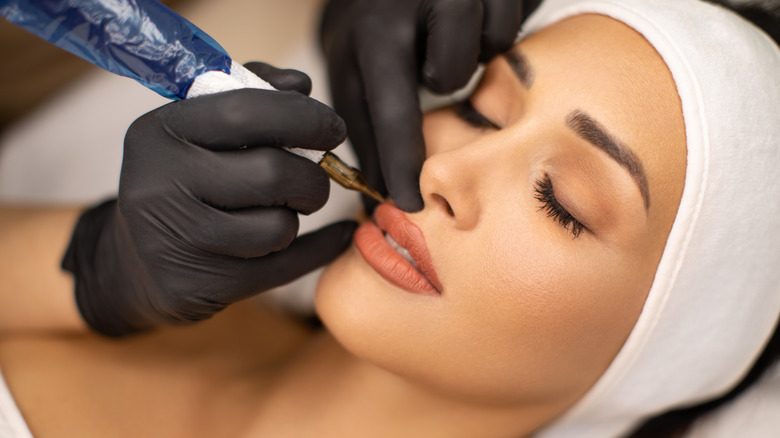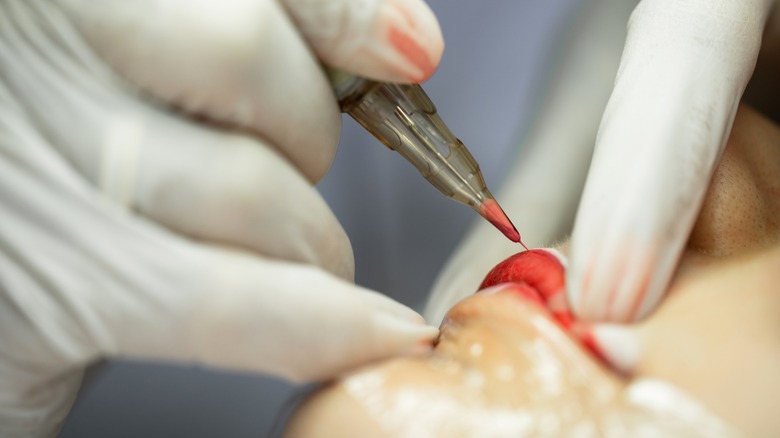What To Know About Semi-Permanent 'Lip Blushing'
Lips are one of our defining features, and with some extra care, they can help us feel more confident as we go about our lives. For some people, lipstick and glosses are enough to accentuate their lips. But for those wanting something more permanent, there are cosmetic procedures out there that offer more of a boost.
You may have heard of semi-permanent makeup procedures like microfeathering and microblading for your brows, or permanent eyeliner for the lashline, and now there's also one specifically for the lips. Lip blushing is a semi-permanent procedure that enhances your natural lip shade with a tattoo machine and ink. It's meant to make the lips fuller without changing the shape or having any fillers or other injectables. It's suited for anyone who wants to correct uneven pigment, improve symmetry and definition, or enhance their lips in a more subtle way.
The results can last for nearly two years and may require touch-ups, depending on how long you want it to last. Lip blushing is an expensive procedure, with professionals charging $1500 on the higher end, while others charge anywhere between $495 and $695. The cost often depends on where you live as well as the artist's portfolio and experience level. With semi-permanent procedures like these, it's important to do your research before making any big moves.
What happens during a lip blushing procedure?
Lip blushing is done by a cosmetic tattoo artist or aesthetician who specializes in semi-permanent makeup. They will use a small mechanical blade that makes tiny cuts in the skin where ink is then deposited. You and the aesthetician will work together to find a shade that works for you, but it's best to bring reference photos or your favorite natural shades of lipstick to show them what you want.
Numbing cream is applied to the lips, and the artist will use a lip pencil to outline the natural shape of your lips in order to have a guideline to go off of. The whole thing typically takes about an hour. People describe a slight pinching feeling along with some pressure, and it's rare that you'll feel a lot of pain. If necessary, more numbing medication can be applied. It's important to communicate with your aesthetician so you can have the most comfortable experience possible.
What's the healing process like?
After a lip-blushing appointment, your lips will feel puffy and irritated, but this is completely normal. It takes a few days for the swelling to go down and for the initial color to fade into a more natural hue. The color will be super vibrant, as shown in a TikTok video from permanent makeup artist @mailaashbrows. Your lips might also appear darker than expected in the days after, but it will fade as your lips heal. "During the healing process, the excess color flakes off," cosmetic tattoo specialist Christopher Drummond explained to Glamour. You can go about your daily life as you normally would, and it's recommended to keep your lips moisturized as you heal.
Your artist may recommend coming in for a touch-up, but this depends on your preferences and needs. Permanent makeup artist Stella Fixman told Cosmopolitan, "The lips take pigment very well, and unless a client wants a bolder look, I don't require second appointments." Other artists might include a touch-up six weeks after the first appointment to give the color a boost. Lip blushing is considered "semi-permanent" because the color does fade over time, typically within 2 to 3 years of the first treatment. Lifestyle factors like sun exposure and smoking can cause the color to fade more quickly, according to the Cleveland Clinic.
Risks associated with lip blushing
Lip blushing is generally safe when done by a seasoned professional, but just like any cosmetic procedure, there are always potential risks involved. Your results truly depend on the aesthetician you go to, and that's why it's important to read their reviews and talk to previous clients before booking with them. Because lip blushing is a tattoo, there are potential risks for infections and scarring. There have also been cases of allergic reactions to the red pigment in the ink. If you have any skin sensitivities or concerns, it's important to communicate these with your artist before having any work done.
Tanya Akim, a writer for Cosmopolitan, tried out the procedure and documented her experiences in an article, explaining how she wishes she had done more research before getting lip blushing. Though it's rare to experience pain during a lip brushing treatment, Akim described being in a lot of pain even after receiving lidocaine. This is a sign that her artist was going too deep into the skin and pressing too hard with the tattoo machine. Because of this, her lips had a hard time healing.
"If I could go back in time, I would insist on picking my own lip color, and I would have also asked the practitioner to stop the service the moment I started feeling the intolerable level of pain that I was in," said Akim.

